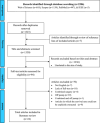Predicting Factors Affecting Survival Rate in Patients Undergoing On-Pump Coronary Artery Bypass Graft Surgery Using Machine Learning Methods: A Systematic Review
- PMID: 39846048
- PMCID: PMC11751876
- DOI: 10.1002/hsr2.70336
Predicting Factors Affecting Survival Rate in Patients Undergoing On-Pump Coronary Artery Bypass Graft Surgery Using Machine Learning Methods: A Systematic Review
Abstract
Background and aim: Coronary artery bypass grafting (CABG) is a key treatment for coronary artery disease, but accurately predicting patient survival after the procedure presents significant challenges. This study aimed to systematically review articles using machine learning techniques to predict patient survival rates and identify factors affecting these rates after CABG surgery.
Methods: From January 1, 2015, to January 20, 2024, a comprehensive literature search was conducted across PubMed, Scopus, IEEE Xplore, and Web of Science. The review adhered to the Preferred Reporting Items for Systematic Reviews and Meta-Analyses (PRISMA) guidelines. Inclusion criteria included studies that evaluated survival rates and predictors associated with CABG patients during the specified period.
Results: After eliminating duplicates, a total of 1330 articles were identified. Following a systematic screening, 24 studies met the inclusion criteria. Our findings revealed 43 distinct factors influencing survival rates in patients undergoing CABG. Notably, five factors-age, ejection fraction, diabetes mellitus, a history of cerebrovascular disease or accidents, and renal function-were consistently identified across multiple studies as significant predictors of postsurgical survival.
Conclusion: This systematic review identifies key factors influencing survival rates after CABG surgery and highlights the role of machine learning in improving predictive accuracy. By identifying high-risk patients through these key factors, our findings offer practical insights for healthcare providers, enhancing patient management and customizing therapeutic strategies after CABG. This study significantly enhances existing literature by combining machine learning techniques with clinical factors, thereby improving the understanding of patient outcomes in CABG surgery.
Keywords: coronary artery bypass; machine learning; survival rate; systematic review.
© 2025 The Author(s). Health Science Reports published by Wiley Periodicals LLC.
Conflict of interest statement
The authors declare no conflicts of interest.
Figures





Similar articles
-
Perioperative risk factors for new-onset postoperative atrial fibrillation after coronary artery bypass grafting: a systematic review.BMC Cardiovasc Disord. 2021 Sep 3;21(1):418. doi: 10.1186/s12872-021-02224-x. BMC Cardiovasc Disord. 2021. PMID: 34479482 Free PMC article.
-
Prediction of postoperative stroke in patients experienced coronary artery bypass grafting surgery: a machine learning approach.Front Cardiovasc Med. 2024 Dec 13;11:1448740. doi: 10.3389/fcvm.2024.1448740. eCollection 2024. Front Cardiovasc Med. 2024. PMID: 39735867 Free PMC article.
-
Predictors of Developing Postoperative Atrial Fibrillation in Patients Undergoing Coronary Artery Bypass Graft: A Systematic Review and Meta-Analysis.Cureus. 2023 Dec 30;15(12):e51316. doi: 10.7759/cureus.51316. eCollection 2023 Dec. Cureus. 2023. PMID: 38288215 Free PMC article. Review.
-
Short-term outcomes of on- vs off-pump coronary artery bypass grafting in patients with left ventricular dysfunction: a systematic review and meta-analysis.J Cardiothorac Surg. 2020 May 11;15(1):84. doi: 10.1186/s13019-020-01115-0. J Cardiothorac Surg. 2020. PMID: 32393284 Free PMC article.
-
Beyond the black stump: rapid reviews of health research issues affecting regional, rural and remote Australia.Med J Aust. 2020 Dec;213 Suppl 11:S3-S32.e1. doi: 10.5694/mja2.50881. Med J Aust. 2020. PMID: 33314144
Cited by
-
Predictive Factors of Length of Stay in Intensive Care Unit after Coronary Artery Bypass Graft Surgery based on Machine Learning Methods.Arch Acad Emerg Med. 2025 Feb 17;13(1):e35. doi: 10.22037/aaemj.v13i1.2595. eCollection 2025. Arch Acad Emerg Med. 2025. PMID: 40352100 Free PMC article.
References
-
- Benjamin E. J., Muntner P., Alonso A., et al., “Heart Disease and Stroke Statistics—2019 Update: A Report From the American Heart Association,” Circulation 139, no. 10 (2019): e56–e528. - PubMed
-
- Kim A. S. and Johnston S. C., “Global Variation in the Relative Burden of Stroke and Ischemic Heart Disease,” Circulation 124, no. 3 (2011): 314–323. - PubMed
-
- Kannel W. B., McGee D., and Gordon T., “A General Cardiovascular Risk Profile: The Framingham Study,” American Journal of Cardiology 38, no. 1 (1976): 46–51. - PubMed
-
- Benjamin E. J., Virani S. S., Callaway C. W., et al., “Heart Disease and Stroke Statistics—2018 Update: A Report From the American Heart Association,” Circulation 137, no. 12 (2018): e67–e492. - PubMed
Publication types
LinkOut - more resources
Full Text Sources
Miscellaneous

